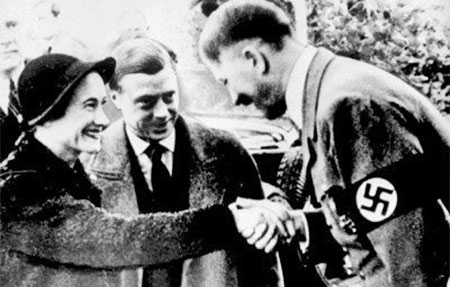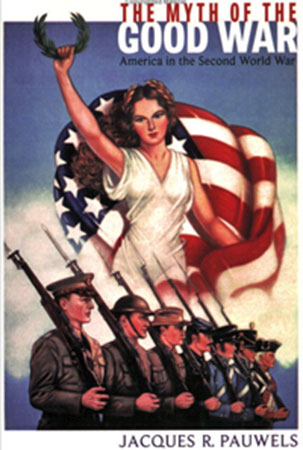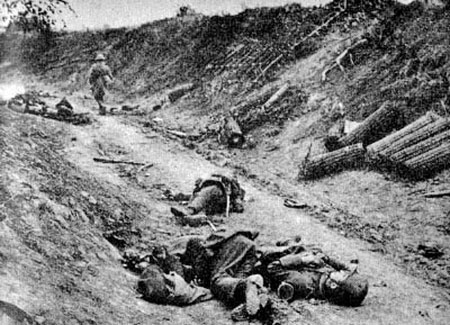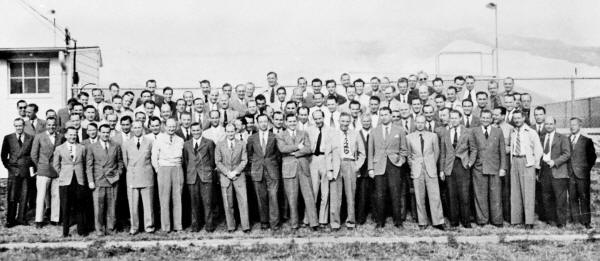|

by Julie Lévesque
December 17, 2014
from
GlobalResearch Website

The Duke and Duchess of Windsor in 1937
with Adolf Hitler.
Dr. Jacques Pauwels
is not the kind of historian you often hear
about in the mainstream media.
He's obviously not
the kind of "expert" they refer to for
historical facts.
Actually, one
crucial propaganda method consists in excluding
current events from their historical context.
Listening to Pauwels
makes one realize the scope of the lies we've
been fed about the Second World War, fascism and
democracy, and how myths related to previous
wars need to be upheld in the mainstream
discourse to satisfy never ending war propaganda
needs.
In a speech held
December 15 in Montreal, he explained that World
Wars I and II were all about crushing mass
revolutionary movements.
The myth of the
Good War

Every time Westerners' approval for war
is required, the myth of the good war surfaces:
the Second World War
was a good war, a necessity to quench Hitler's blood thirst.
Pauwels tears this myth apart,
uncovering
the vicious nature of the western elite.
The reasons for the US involvement in
World War II lie in the social-economic conditions of the time, not
in an outpouring of compassion destined to save humanity from
fascism. The US elite was actually in favor of fascism, a very
convenient tool to crush the mass revolutionary movement embodied by
the Russian Revolution and the USSR.
WWII was in fact a continuity of WWI.
"We are always told that WWI started
with the assassination of Archduke Franz Ferdinand, but it's not
true", Pauwels says.
It is indeed a well established myth
carried on by various sources, whether history is written by "thousands
of eminent experts, scholars, and leaders" like in
Encyclopedia Britannica, or by just about anybody, like in
Wikipedia:
The outbreak
of war
With Serbia already much aggrandized
by the two Balkan Wars (1912–13, 1913), Serbian nationalists
turned their attention back to the idea of "liberating" the
South Slavs of Austria-Hungary.
Colonel Dragutin Dimitrijević, head
of Serbia's military intelligence, was also, under the alias "Apis,"
head of the secret society Union or Death, pledged to the
pursuit of this pan-Serbian ambition.
Believing that the Serbs' cause
would be served by the death of the Austrian archduke Francis
Ferdinand, heir presumptive to the Austrian emperor Francis
Joseph, and learning that the Archduke was about to visit Bosnia
on a tour of military inspection, Apis plotted his
assassination.
(World
War I, Encyclopedia Britannica)
The immediate trigger for war was
the 28 June 1914 assassination of Archduke Franz Ferdinand of
Austria, heir to the throne of Austria-Hungary, by Yugoslav
nationalist Gavrilo Princip in Sarajevo.
This set off a diplomatic crisis
when Austria-Hungary delivered an ultimatum to the Kingdom of
Serbia, and international alliances formed over the previous
decades were invoked.
Within weeks, the major powers were at war
and the conflict soon spread around the world.
(World
War I, Wikipedia)

Both WWI and WWII had two dimensions, Pauwels
explains:
-
the vertical dimension, namely the rivalry between empires
-
the
horizontal one, class warfare
These wars were actually the best way
for the western elite to cope with the ever growing revolutionary
and democratic movements fueled by dire economic conditions and
which threatened the established order.
In Nietzsche's view for example, Pauwels
says,
"war was the solution against
revolution, since in a war, there are no discussions, like there
is in a democracy. In a war,
the minority, the elite, decides
and the majority, the proletarians, obey."
For members of the elite like Malthus,
"the system could not be the cause
of poverty since they were profiting from it. The cause of
poverty was the poor: there were too many of them.
Therefore the solution to poverty
and threatening revolutionary movements was simply to eliminate
poor people and what better solution than war to kill poor
people?"
After WWI though,
"revolution was no longer a simple
idea but rather something concrete: the Soviet Union."
That's when fascism came to the rescue.
"Fascism was the instrument used by
the elite to further the objectives of 1914, namely put an end
to revolutions and communism."
Communism and socialism were gaining
worldwide momentum after WWI.
"The German industrial and financial
elite wished to crush the revolutionary movement and destroy the
Soviet Union. Adolf Hitler was their instrument."
According to popular belief Western
leaders were defending democracy, engaged in a war against Germany
to save humanity from fascism and the US involvement in the war led
to the downfall of Hitler's war machine.
Nothing is further from the
truth.
"Hitler was supported by other
European countries and the US because they wanted him to destroy
the USSR, the cradle of the revolution."
The exact opposite occurred: it was the
USSR that defeated Nazi Germany, losing over 20 million souls in the
battle.
The US even recruited the best Nazi
scientists, technicians and engineers to work for them after the
war. That piece of history called
Operation Paperclip (picture below) has yet to find its way in
Encyclopedia Britannica.

WWII was the victory of
American
Imperialism, a term which is rarely used today even if it best
describes the reality the world has been living in ever since.
But even more surprising is the
surviving myth that we are going to war to 'save the world' from evil
dictators or terrorists and that the western world fights for
freedom and democracy.
Thanks to the "stenographers of power",
the tactic is still reliable and used several decades later.
|




